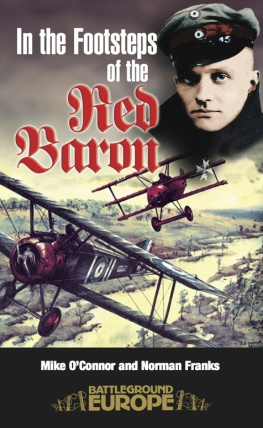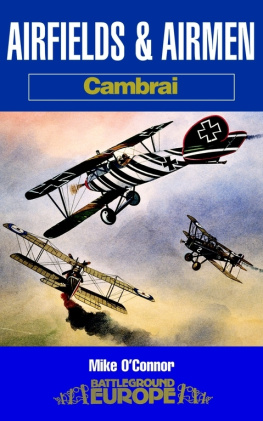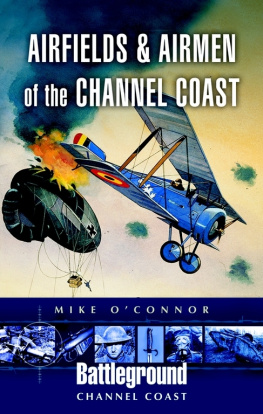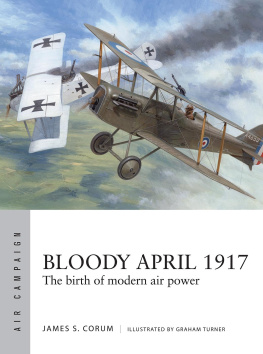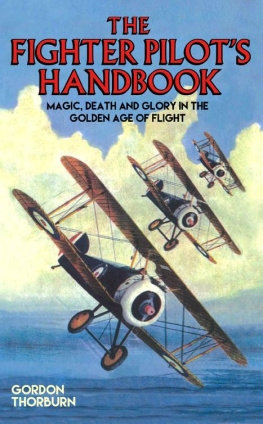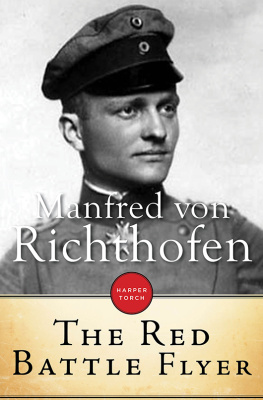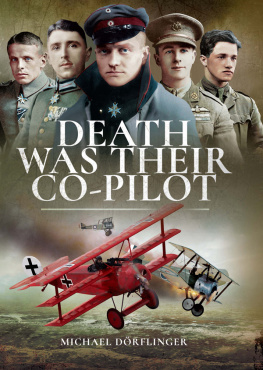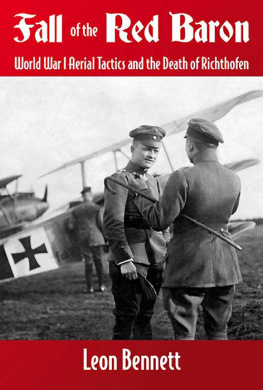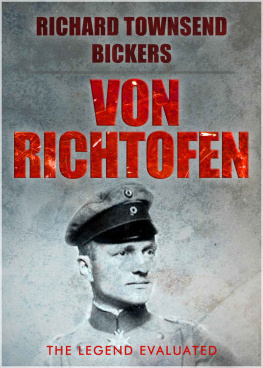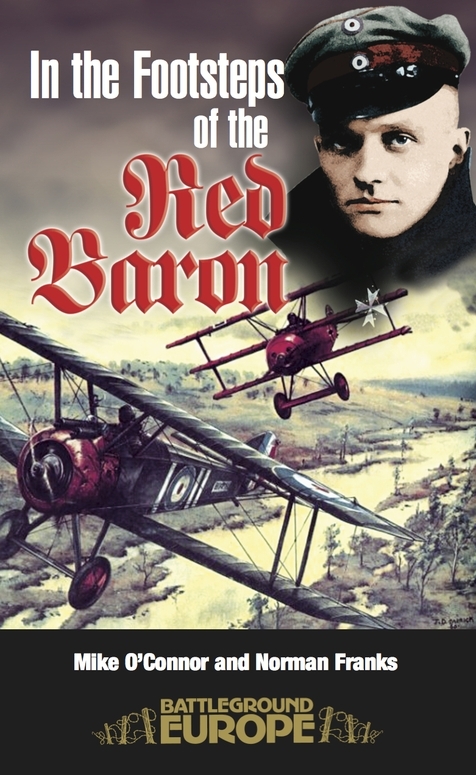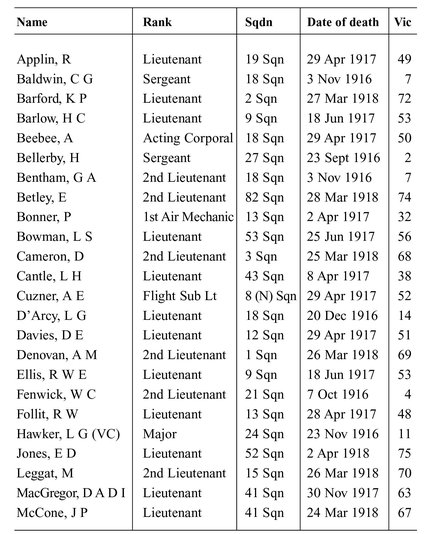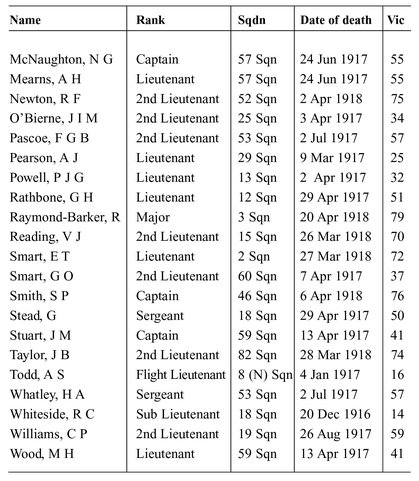We would first of all like to acknowledge the help of Peter Coles, the aviation editor for Pen and Sword Books for his help.
Secondly, I would like to thank Sylvia Menzies for the layout of the book.
We would also like to thank the following: Paul Baillie; Nigel Cave for his series introduction; Jacques de Ceuninck; the Commonwealth War Graves Commission; Bernard Deneckere for his invaluable information regarding Harlebeke and Ghistelles aerodromes; the German War Graves Commission; Hal Giblin; Barry Gray; the staff of the RAF Museum; Trevor Henshaw; Alex Imrie; Phil Jarrett; Wing Commander Jeff Jefford; Stuart Leslie for his great help with photographs; Bob Lynes; Walter Pieters; the staff of the Public Record Office; Claire Beric and Greville Raymond-Barker; Alex Revell; the staff of the Service Historique de lArme de lAir ; William Spencer; Jeff Taylor; Stewart K Taylor; the late Bruce Robertson; Les Rogers; Ray Sturtivant; Lawrie Woodcock; Barry Woodward.
Every effort has been made to contact the authors of the various books or articles quoted and their copyright is acknowledged.
USING THE GUIDE
There have been many guides to the various battlefields of the Western Front, some of them extremely detailed, but there have not been any concerning the flying aspect. Using old photographs, maps and contemporary accounts we visited old aerodrome sites and was amazed how little many of them had changed. You can hold up an old photograph of some of them and the scene behind today appears only to lack the aeroplanes. In fact many of the farms associated with these aerodromes have probably changed little in two or three hundred years.
For the military historian most of the First Wold War has a convenient chronological and geographical sequence in that one can relate how far a battle progressed (or not as the case may be) on a day-by-day basis. The air war unfortunately does not fit into this tidy pattern. Squadrons or flights would take off from one point, have a fight or range an artillery battery at another and casualties would be spread all over the front, on both sides and many miles behind the actual fighting. Casualties from a single air battle might be buried in different cemeteries miles apart.
This guide has attempted to link interesting events and individuals together, into some sort of logical and digestible order, despite the differences in time and geography. The choice of personalities and events is purely our idea of what is interesting. There has always been the glamour of the scout or fighter pilot and the aces and in recent years there has been what we consider an unhealthy obsession with trying to discover who shot down whom. This at best is a risky past-time, taking into account the confused nature of an air battle, the fallibility of human memory and sometimes the marked absence of German records. The air war was not just about aces but involved all the mundane tasks of photography, reconnaissance, artillery ranging, bombing, tank co-operation, infantry co-operation, supply dropping and all the myriad tasks that enabled the Allied armies win the war. To concentrate on just one aspect of the aerial battle does not do justice to the rest.
However in a book of this kind one cannot ignore the aces theme, though we use the information of who got who advisedly and would hope that we have presented a reasonably balanced picture of what the first air war was like.
This book has been written in the same format as Mike OConnors Airfields and Airmen series and, as such, the same principles apply. At the front is a map showing the main features in the book and then there are four separate tours, each with their own map.
THE TOURS
We have assumed that the majority of readers will be originating from the UK and thus have started the guide at Calais because of good access via the ferries and Channel Tunnel. The first chapter takes the visitor on a linear tour from Calais to Arras, which is a handy centre from which to begin the next two tours. The historic and attractive town of Arras has a number of good hotels and restaurants. Chapters Two and Three have been constructed as circular tours based on Arras. The last chapter takes the visitor back to Calais via a number of interesting sites.
Touring the sites and locations we suggest is a personal matter, depending on the interest of the traveller, the time available, or what one would like to achieve. We have suggested four itineraries, that can be done in one continuous journey, taking in a few night stops, or perhaps follow the four tours in quite separate visits. We have tried to make the journey as simple as possible, with reasonably detailed directions but the visitor if going by car would certainly benefit from a sensible navigator by his side with a good map; preferably a modern one, not one dated 1917!
UNKNOWN CASUALTIES
Many of von Richthofens victims were either too badly burned to be identified by the Germans or their graves were subsequently lost. As such they are now remembered on the Air Forces Memorial to the Missing at Faubourg dAmiens in Arras. Their names are listed in Appendix A, which will enable the visitor to pick them out during the visit to it. Because of the number of names the entry for Faubourg dAmiens would be extremely large and thus just a few of the casualties have been selected for a potted biography. This in no way reflects on whether one person is less worthy of attention than another.
CEMETERIES
Every von Richthofen casualty has been covered and the location of graves is given at each burial ground. However, it is a good idea to take the cemetery register with you around the site as plot numbers and their positions can be confusing. In addition the excellent Commonwealth War Graves Commission website now has plans of the cemeteries for those visitors who want to plan ahead. Appendix B gives the casualties in each cemetery in the order that they appear in the book.
AERODROMES
Most of the aerodromes have diagrams so the visitor can orientate themselves and envisage where the hangars, sheds etc were located. Unfortunately for some, such as Pronville, it has been impossible to find any accurate information so visitors are directed to the relevant spot and left to use their imagination. There are also modern aerial shots to show present-day features and allow the visitor to see where all the main points are. At the back of the book are three appendices. Appendix C gives a listing of all von Richthofens victories and the names of the crews, together with their fate. This is used in conjunction with the aerodrome visits to show the victories the Red Baron scored while based at each site. The list also indicates where the dead are buried, which will link up with the visits to cemeteries.
APPENDICES
Appendix A
Names of Von Richthofens Victims on the Arras Memorial
Appendix B
Casualties in Cemeteries involved with the Red Baron as they appear in the Tours
| Harlebeke | W H T Williams victory No. 58; |

